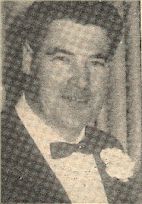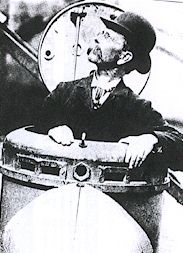|
People of
Importance that
came from County Wexford…
General
Abercromby
His
fame was more assured than ever, and he was sent to Ireland in
December 1797 to command the troops there. He had had a great
experience of the state of Ireland when his regiment was stationed
there, and, knowing what he did, refused to be hoodwinked by the
officials at Dublin Castle, or to connive at their schemes. The
situation was a |
perilous
one.

The
English cabinet and Irish officials had fixed their attention on the
intrigues of the leading patriots and club orators, rather than on
the populace would take part in a rebellion. And this populace had
been inflamed to revolution pitch more by the arbitrary and cruel
proceedings of the troops in Ireland than by the declarations of
demagogues or the bribes of the French directory.

The late
commander-in-chief Luttrell, Lord Carhampton, had been ferocious
enough, but it was ratherof the conduct of the troops than of their
commanders that the Irish people complained. The garrison of Ireland
consisted nearly entirely of English and Scotch militia and
protestant Irish yeomanry. Without the discipline of soldiers, they
committed most fearful excesses, and the officials wished to condone
their |
 |
offences because the
militia were only serving in Ireland as volunteers, and could
demand to be sent home. Abercromby was too thorough a soldier
to meet their wishes, and on 26 February 1798 issued his famous
general order, that the militia were far more dangerous to their
friends than their enemies.

The castle soon wished to
get rid of this obnoxious Scotchman who would abuse their yeomanry,
on which they depended, and try to remove the militia, whose
services they wanted, and who seemed to expect that the Irish
peasants should not be wantonly ill-treated; the authorities soon
made a pretty quarrel between him and Lord Camden, the lord
lieutenant, on which Abercromby resigned his command. He soon
found he was not in disgrace at home, for he was at once appointed
commander of the forces in Scotland.
. |
| Unsung Irish Hero
of Three Wars |
|
An Irish
soldier who won the Victoria Cross, the highest British award for
gallantry in battle, is unlikely to be remembered with total pride
in British military annals.
.
After returning as a hero from the Great War in France,
where he also won the Military Medal, he threw in his lot with the
national struggle for freedom in 1920 and spent the next few years
fighting the Crown forces in Ireland. Then with the ending of the
War of Independence, he signed up with the new free State Army and
saw more action in the Civil War that followed the signing of the
Treaty.
.
When
peace came again he |

Sergeant
Major Martin Doyle of New Ross, Co. Wexford,
is greeted by Queen
Mary before being doubly
decorated
with the Victoria Cross and the Military Medal
by King George V
at Buckingham
Palace.
|
continued to serve in
the Irish army, ending his career in Dublin’s McKee Barracks in
1937.
.
The man
with this distinguished and chequered military career was Martin
Doyle, born in Gusserane, in the New Ross district of Co.
Wexford. His family were ordinary country folk, his father Larry
Doyle working on the land to make a modest living. When Martin was
still a boy the family moved into New Ross
town. |
| They Made their
mark in America |
 |
Peter
FitzPatrick
from Fethard-on-Sea who is included in the ‘Irish-American
Who’s Who’. |
 |
Lieut-Commander John J. Ryan
who became a Judge in Brooklyn, is
son of Pierce Ryan from Davidstown,
Glynn |
| . |
|
The heights
and fame achieved in America by men like Commodore John Barry
and President John F. Kennedy from humble Wexford origins is
a source of great pride for our county. It is also a reason why many
American tourists come to Wexford, for they share this pride with
us.
.
Barry and Kennedy are the big names, but there are many other
lesser known Wexfordmen who have distinguished themselves in the
United States, of whom we can feel proud. How many know, for
example, that the son of a Taghmon man was the first Irish
Catholic to be elected to the United States Congress for the State
of Oregon, having already distinguished himself in the State
Senate.
.
He was
Nicholas Sinnott, whose father, Nicholas Byrne
Sinnott, emigrated from Aughfad, Taghmon, in 1832, and became
one of the best-known and most influential private citizens in the
Pacific North West.

There were so many tributes to him in the
newspapers when he died in 1897 that they were printed in book
form.

His son Nicholas (born 1870)
qualified as a lawyer after attending Notre Dame University in
Indiana. He became an outstanding figure in the Oregon State
Legislature, where he pioneered several historic pieces of
legislation and reforms.
.
Two
Wexford men became leading churchmen in America. John Mitty,
whose father emigrated from Churchtown, Carne, was Archbishop of San
Francisco for twenty-six years (1935-1961), having previously been
Bishop of the Diocese of Salt Lake, Utah, professor of theology and
chaplain in the U.S. army (1917-1919).
.
It is surprising that more tourism mileage is not derived
from the fact that ‘Buffalo Bill’s’ father, William Cody was
born in the premises, now Kelly’s Lounge on the King St. –Barrack
Str. Corner in Wexford. Buffalo Bill himself was born in
Scott County, Iowa, in 1846. A rugged frontiersman, he rode the Pony
Express and was a scout for Union troops during the American Civil
War. He got his famous name from being a buffalo hunter and
supplying meat for the workers building the continental
railroad.
.
From
Wexford, too, came the famous caricaturist, Harry Furniss
(1854-1925) who, in 1912, worked in New York as a film writer, actor
and producer, having first visited the U.S. on a lecture tour in
1892. His first sketch for the famous ‘Punch’ magazine appeared in
1880.
.
Wexford is proud to lay claim
to the leading American film star, Dan O’Herlihy who was born
here – his mother was Nellie Hanton, a member of a once prominent
business family in the town, and his father was Manager of the
Labour Exchange.
.
A Wexford
man who reached the top in the legal world in New York was Judge
John Ryan of Brooklyn. Born in 1911, his father was Pierce Ryan
from Davidstown, Glynn, and a kinsman of the notable Ryan dynasty of
Tomcoole, which included Dr. James Ryan, 1916 veteran and government
minister.
.
Judge
Ryan, who visited
Wexford twice, was also a member of the New York State Legislature
and served with the U.S. Navy during World War II, retiring with the
rank of Lieut. Commander. He has been a prominent member of the St.
Patrick’s Society in Brooklyn.
.
A number of Wexfordmen are listed in the ‘Irish-American
Who’s Who’ published in 1884. James Murphy Jr., whose father
emigrated from New Ross to Detriot in 1907, became a State
government official in Arizona. He served in the U.S. Marine Corps
as a technical sergeant (1942-1945) and saw action in Guadalcanal,
Guam and Iwo Jima in World War II, receiving the Presidential Unit
Citation.

He was appointed by the Governor of Arizona
as Director of Veterans’ Affairs in 1951. He joined the
Irish-American Club of Arizona and was founder and first president
of The Friendly Sons of St. Patrick of Arizona in
1953.
.
George Alexander Murphy, born in Wexford town in 1930,
served as steam foreman with the Board of Education in New York,
having served in the British merchant navy before going to New York
in 1952.
.
Peter
Laurence Cullen,
who received a number of decorations for service with the U.S. army
in the Vietnam War, also had Wexford Parents.
.
Thomas Cullen served with the Old I.R.A. the Irish army from 1921 to 1926
and after going to America was actively involved with the GAA in New
York.
.
Another Wexfordman listed in
the ‘Irish American Who’s Who’ is Peter Joseph FitzPatrick
from Fethard-on-Sea, son of Peter and Mary (Roche) FitzPatrick.
Before emigrating after a few years working in Bermingham, Peter
served in the Irish army in Clonmel and Fermoy. He founded the
United Irish Institute in New Jersey and organised the Easter Sunday
1916 commemoration parade on Broad Street, Newark, New Jersey,
believed to be the only parade commemorating the 1916 Rising held in
North America.
.
Mother Johanna Butler,
the first American to be named Superior General of the
French-founded Congregation of the Sacred Heart of Mary, was
educated by the Sisters of Mercy in New
Ross. |
John Holland,
‘father of the Modern
Submarine’
There is an interesting link between John Holland
(1841-1914), the inventor of the submarine and Enniscorthy.
Holland was son of a Co. Clare coast guard and was interested in a
career at sea but poor eyesight prevented him from doing so. He
became a Christian Brother and taught for some time at Enniscorthy
C.B.S.
.
Holland became involved with
the Fenians, dispensed with his vows, and headed for America. He
experimented with building a submarine and after some years he built
one that worked. In 1895 he formed a company and set about
developing his invention. His second effort, the ‘Holland’ passed
U.S. tests. The British navy became interested and purchased a
number of Holland submarines for use in naval warfare, John Holland
is generally recognised as the ‘father of the modern |

The diminutive creator of
the Submarine
in 1903,
John
Holland |
| submarine’ but his links
with Enniscorthy are not generally
known. |
| . |
|
We are
only too happy to help out
if you are trying to trace your
ancestors
when you are staying with us at
Cedar
Lodge. |
|